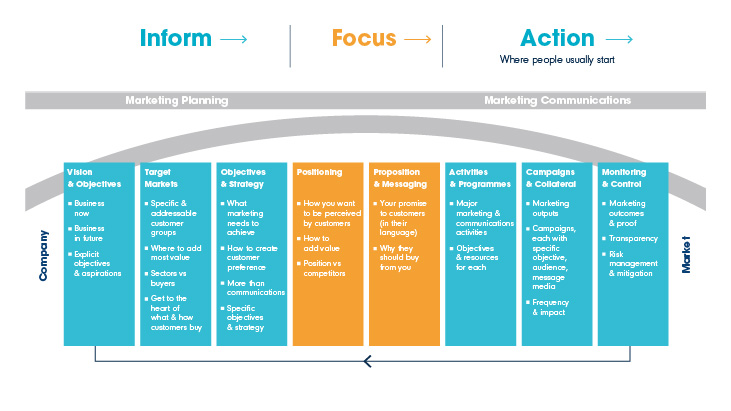
It’s no coincidence one of the best-selling books on brand positioning is subtitled ‘The battle for your mind.’1 Because no matter how much marketers like to think market share is won and lost online or in the trade press, the real struggle plays out inside the heads of their customers. Whoever wins the battle there, wins the war.
But what is positioning? How do you achieve it? Or at least influence it? And what benefits does it bring for your business? In examining how to position your brand in this article, we hope to answer these questions, and more.
So, what is brand positioning?
Positioning has been described as “the act of designing the company’s offer and image so that it occupies a distinct and valued place in the target customer’s minds.” 2
The key lies in creating a perceived difference for your brand, which, as far as your customers are concerned, means it has something different or better to offer than others in the same category.
We know a product’s functional features and benefits will only take it so far in the race to be the customer’s preferred brand. And they certainly won’t help it stand out alongside its near-identical competitors.
But when it has values and associations customers can relate to, it can make a huge difference.
Take the most basic of canned commodity groceries, baked beans, for example.
All baked beans are a go-to fix when you need a quick, affordable hot meal, regardless of whose name is on the can. But look how the category leader [you know the one. Beans with a ‘Z’] takes it further.
Their brand is about more than taste and convenience. It’s also about a meal that’s high in protein and fibre and low in fat. A way for parents to be reassured they’re looking after their family’s health. So the brand takes up a position of responsible, healthy parenting in their mind.
When they decide they need more beans for the store cupboard, they don’t have to compare the nutritional value of competing brands on the shelf or consider price differences of a few pence. The values of the leading brand, which chime with their own, provide a shortcut that makes it the automatic choice, every time.

You know what beanz meanz… how to position your brand to align with your customers’ values.
Other brands of beans might focus on affordability: A square meal for kids for just a few pence. Or they might choose to play up ease and convenience: A way for busy parents to put a hot meal on the table in minutes.
Each of these positions is relevant to a particular kind of customer. Each is different from the next – deliberately so. And each one serves to separate one brand of beans from another. Even though, stripped of their brand values and packaging, they’re all just baked haricot beans in a bright orange tomato – flavoured sauce.
Finding the position that’s right for your brand
In categories that are busy with competing brands, positioning allows you to stake your claim in the market with the point of difference that’s most powerful and relevant to your customer.
The hard work comes in finding and developing that point of difference.
For starters, your chosen position must be unique. Whether it’s The Cheapest, The Most Durable, The Best Made or The Tastiest, there is only room for one in any given category.
And just saying it’s so doesn’t make it so [as so many brands that choose to tag themselves as ‘The best quality XXX money can buy’ have discovered to their cost]. Consumers are smarter than that. They can spot overclaims and advertising bluster a mile away.
So, while successful brands establish a point of difference by focusing on their product’s provenance, heritage or scientific credentials, such claims must be rooted in some product truth. If they’re not, the credibility gap between the ‘reason to believe’ and reality becomes too wide to support a sustainable position.
Neither is it a good idea to muscle in on another brand’s position. They already have the high ground and, once established, brand loyalty is difficult to shift. At best, you’ll be seen as a copycat brand and by definition, inferior. At worst, you’ll be ignored altogether.
Just as important, your brand position must directly address the needs of the customer and be relevant to them. You can’t position yourself in a space just because no-one else is occupying it. Most markets are overcrowded with brands, each trying to slot into the minds of the consumer in a relevant way. If one of those slots is empty, there’s probably a good reason.
‘The chocolate flavoured aluminium inspection panel’ might be a unique position in the market. But there’s a good reason it’s available: It’s neither relevant nor useful to the customer.
Two basic brand positioning rules
When clients come to Intermedia for advice on positioning their brand, there are two things we always emphasise:
First, however you choose to position your brand, it has to be in a space where it can thrive without too much in the way of extra operational effort for your production lines, logistics chain and service teams.
Second, it mustn’t exclude your existing customer base. Existing customers are the beating heart of any business. Excluding them to chase after new customers you may or may not land is a huge risk. Both economically, and to the long-term reputation of your brand.
The only exception to this rule is when brand owners deliberately set out to create other, standalone brands to target a new customer base within their category.
Toyota’s stewardship of the Lexus brand, for example, is a very deliberate move into the luxury vehicle market it can’t service with its mid-market models.
And Coca-Cola manages numerous brands, including Dr Pepper, Fanta and others, that each occupy a distinct position in the soft drinks market and all deliver a handsome profit to their parent company.
How to position your brand: The process
The answer to the question ‘how to position your brand’ is complicated.
It involves influencing customers’ thoughts and opinions. Finding a place for your brand that is unique. Understanding customers’ emotional reactions to brands. And addressing their needs and values in your marketing messages.
So what’s the best way to go about developing a position for your brand that you can own and exploit for maximum sales and profit?
The ‘classic’ positioning process follows a four-point plan:
- The start point is to look at the competitive dynamics of the market. Is price the biggest driver? Service levels? Product range? Look at the essential elements and functions of your competitors’ brands to understand how they might deliver on those key points
- Next, work down through these functions and benefits to identify each products’ uniqueness in the market – the one space in which they hope to engage their audience
- Assess how these products develop emotional and symbolic appeal in the category. In other words, how they turn their uniqueness into a brand position that matters to the customer
- Based on the intelligence you have gathered and the spaces you have identified, develop a brand platform for your product in the category
It looks simple on paper. But this part of the positioning process can be a long, involved task. And as a simple template, it doesn’t always fit neatly with the needs of every business.
How to position your brand in a service sector
For instance, what if your business isn’t about producing physical products that customers can buy off the shelf? What if your offer is service-based instead? How then do you create a distinctive position that resonates with your customers?
In this case, the focus for differentiation shifts to who delivers the service, and how well they do it.
Take car breakdown organisations, for example. All employ mechanics, in a fleet of vehicles, armed with tools and diagnostic equipment to get you going again when your car breaks down.
But not all will support the motorist in other ways. With advice on nearby hotels if an overnight stop is needed, or by keeping children occupied and entertained with a supply of toys or games.
It’s by focusing on these additional elements beyond the ‘nuts and bolts’ benefits that service brands can build emotional ties and occupy a unique position in the customer’s consciousness.
Because of this, the front line employees of such organisations become critical brand ambassadors, embodying the values of the brand and building positive relationships with customers.
Precisely the reason why, from the famous roadside salute to AA members, through to their incarnation as ‘the 4th Emergency service’, AA technicians have been central to sustaining the brand’s position as the number one roadside assistance provider.

The AA’s brand position has been sustained by its vehicle mechanics for over a century.
The Intermedia position
Brand positioning is a critical pillar for supporting and growing your brand in a competitive market. But it’s not the only one.
So our approach to positioning takes its place in a broader brand development process. One in which our Strategic Marketing Framework plays an intrinsic part. Image:

Determining how to position your brand is a key part of the strategic marketing process.
By following this framework, and through painstaking intelligence gathering, we will conduct a brand audit for your business. A comprehensive assessment of where you stand in your sector compared other companies offering similar or the same products.
This helps us establish where your brand needs to be to compete more effectively. Which, in turn, informs your brand vision, values and personality.
And from there, we’re able to define the most appropriate and compelling brand position.
The objective is to occupy and own a distinct space in your market and your customers’ minds that sustains the highest levels of brand loyalty and profit.
To create clear blue sky, if you like, between you and your nearest competitors.
The benefits of a clear, coherent brand position can’t be overstated. It will improve your brand recognition. Build sales and customer loyalty. Improve cash-flow and profits. And give you a reliable source of revenue that allows you to plan with confidence for years, even decades ahead.
When you need advice and direction on something as critical to the success of your business, talk to the experts. Talk to Intermedia.
1 Positioning: The battle for your mind. Al Ries; Jack Trout. [New York : McGraw-Hill, 2001]
2 Phillip Kotler and Kevin Lane Keller, Marketing Management ,14th ed. [Upper Saddle River, NJ: Prentice Hall, 2012].
Originally published November 30, 2022 09:44am, updated April 19, 2023
